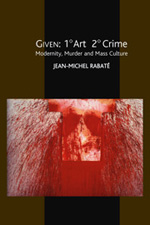
[Cliquez ici pour lire le compte-rendu dans la revue Acta fabula]
Jean-Michel Rabaté
Given: 1° Art 2° Crime. Modernity, Murder and Mass Culture
Brighton et Portland
Sussex Academic Press, “Critical Inventions”
2007
228 p.
This exciting new study investigates links between avant-garde art and the aesthetics of crime in order to bridge the gap between high modernism and mass culture, as emblematized by tabloid reports of unsolved crimes. Throughout Jean-Michel Rabate is concerned with two key questions: what is it that we enjoy when we read murder stories? and what has modern art to say about murder? Indeed, Rabate compels us to consider whether art itself is a form of murder. The book begins with Marcel Duchamp’s fascination for trivia and found objects conjoined with his iconoclasm as an anti-artist. The visual parallels between the naked woman at the centre of his final work, ‘Etant Donnés’, and a young woman who had been murdered in Los Angeles in January 1947, provides the specific point of departure. Steven Hodel’s recent book has thrown new light on what was called the 'Black Dahlia' murder by pointing to one of Duchamp’s friends, Man Ray, who, according to Hodel, was the murderer’s inspirator. This putative involvement recalls Walter Benjamin’s description of Eugene Atget’s famous photographs of deserted Paris streets as presenting ‘the scene of the crime’. Indeed, this phrase was used as the title for Ralph Roff’s 1997 exhibition, which implied that modern art is indissociable from forensic gaze and a detective’s outlook, a view first advanced by Edgar Allan Poe who invoked both criminal detection and manuscript studies in his 1846 essay ‘Philosophy of Composition’. Arguing that Poe’s fanciful account of the genesis of his story ‘The Raven’ can be superimposed onto his deft solving of murders like that of the ‘Rue Morgue’ or of Marie Roget, the author goes on to suggest that Poe’s aesthetic parallels Thomas De Quincey’s contemporaneous essay ‘Of Murder Considered as one of the Fine Arts’.